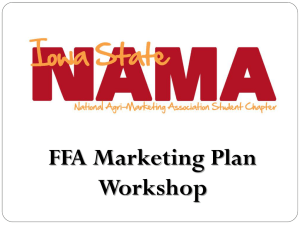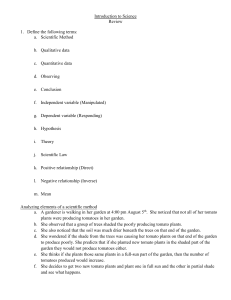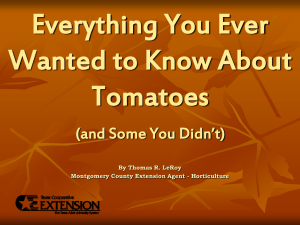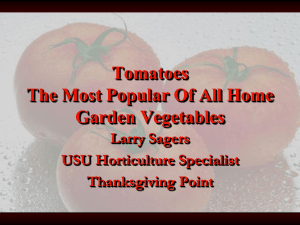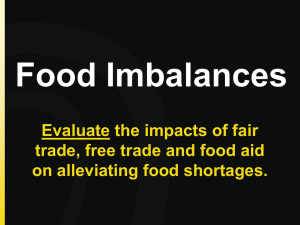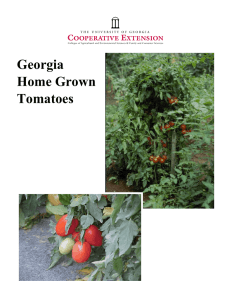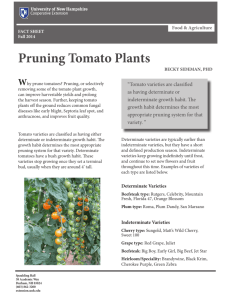Volunteer Newsletter for 03-17-2014
advertisement
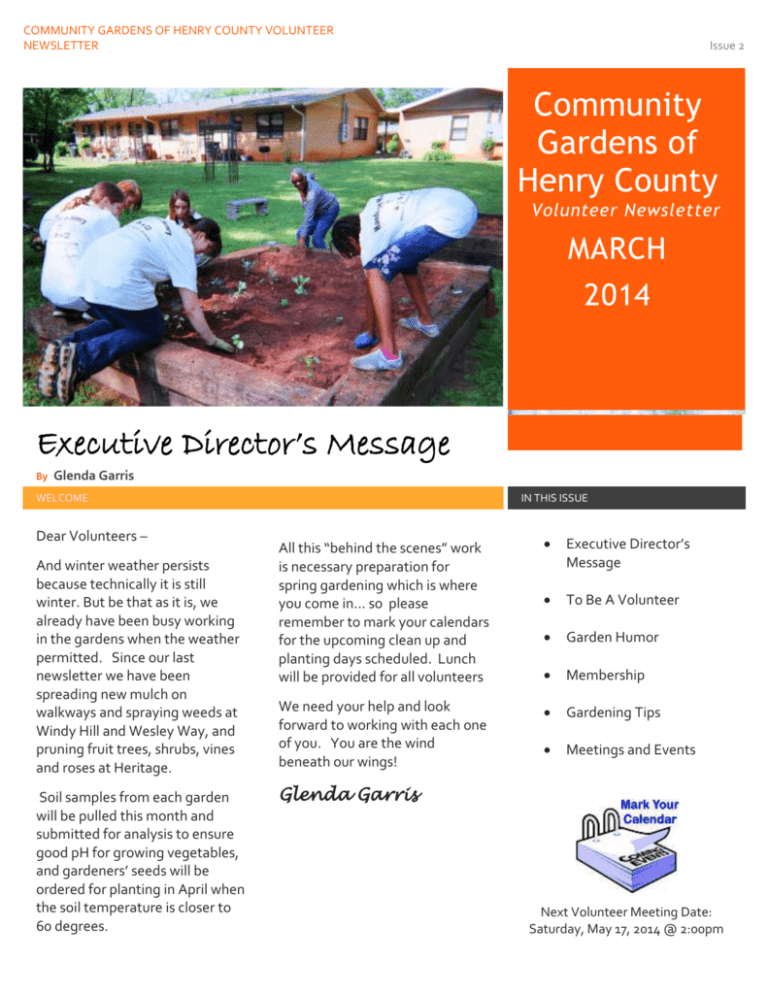
COMMUNITY GARDENS OF HENRY COUNTY VOLUNTEER NEWSLETTER Issue 2 Community Gardens of Henry County Volunteer Newsletter MARCH 2014 Executive Director’s Message By Glenda Garris WELCOME Dear Volunteers – And winter weather persists because technically it is still winter. But be that as it is, we already have been busy working in the gardens when the weather permitted. Since our last newsletter we have been spreading new mulch on walkways and spraying weeds at Windy Hill and Wesley Way, and pruning fruit trees, shrubs, vines and roses at Heritage. Soil samples from each garden will be pulled this month and submitted for analysis to ensure good pH for growing vegetables, and gardeners’ seeds will be ordered for planting in April when the soil temperature is closer to 60 degrees. IN THIS ISSUE All this “behind the scenes” work is necessary preparation for spring gardening which is where you come in… so please remember to mark your calendars for the upcoming clean up and planting days scheduled. Lunch will be provided for all volunteers We need your help and look forward to working with each one of you. You are the wind beneath our wings! Executive Director’s Message To Be A Volunteer Garden Humor Membership Gardening Tips Meetings and Events Glenda Garris Next Volunteer Meeting Date: Saturday, May 17, 2014 @ 2:00pm COMMUNITY GARDENS OF HENRY COUNTY VOLUNTEER NEWSLETTER | Issue 2 TO BE A VOLUNTEER it takes... Generosity, a willingness to give your time to others. WATERMELONS AND PEPPERS FROM WESLEY WAY 2 to our newest members: Kathleen Jimenez Lauren Ogilvie Trebbe Shaw Melissa St. Clair Lindsey Windsor Adrianna Fluker Sharee Stephen Cynthia Vega Casey Wang Darius Roberts Understanding, because their lives might be very different from your own. Empathy, an ability to put yourself in someone else's shoes and feel what they must feel. Compassion, to truly care about making someone else's life better. Patience, because the process doesn't always go as smoothly as it might. Gardening Tips If you grew up in the South, then you will know what I mean when I say “get your white bread and mayonnaise ready! “ It’s almost tomato planting time and I can already taste that delicious red, juicy tomato on my white sandwich bread with lots of mayonnaise and salt and pepper. Doesn’t the thought make you want to run right out and get started on your tomato bed? Dedication, to stick with the project and see it through. You've shown these qualities and so much more, so thank you for all that you do. Garden Humor Selecting Tomato Plants CABBAGE FROM WINDY HILL What do you get if you divide the circumference of a pumpkin by its diameter? Answer: Pumpkin pi. What does everyone have on their face? Answer: Tulips What do you call a stolen yam? Answer: A hot potato. It’s a little early yet for planting outside, but we can start thinking about what tomato varieties to put in our gardens or patio pots. And we all have our favorites! Some of mine are Big Boy, Better Boy, Big Beef and Jet Star. Determinant varieties are those that grow to a point, set fruit and then decline. Most of the early varieties are determinant and will not produce for the entire summer. I prefer the in-determinant tomato varieties because they will generally produce fruit until the frost; however, the plant also grows large and will need to be properly supported and pruned as the season COMMUNITY GARDENS OF HENRY COUNTY VOLUNTEER NEWSLETTER | Issue 2 progresses. Fusarium and verticillium wilt are common tomato diseases. When buying transplants, look for plants that are resistant to these two diseases; they are labeled VF. If you see plants labeled VFN it means the plant is resistant to verticillium, fusarium and nematodes; VFNT includes resistance to tobacco mosaic disease Planting and Tending Tomato Plants Tomatoes love well drained soil with lots of organic matter. The pH should range between 6.0 to 6.5. A soil test can help you determine the pH of your soil and provide recommendations for adding dolomitic lime and other nutrients. Our southern soil is often too acidic and will need the addition of lime. However, it takes a while for the lime to change the soil pH so it should be added in the fall for best results. And of course, you will need to add fertilizers as indicated from your soil analysis two to three days before planting. If you did not have a soil test, generally1-1/2 lbs of fertilizer like 10-10-10 per 100 square feet can be applied. Tomatoes are heavy feeders so remember to fertilize again every three weeks as a side dress once tomatoes form on the plant and until you have harvested all the tomatoes. Always plant your tomatoes in full sun about 3 feet apart so there is good air circulation. And plant them deep – up to the first set of true leaves on the plant. It also is a good idea to rotate the planting sites every year. You should add 2” to 3” of mulch to your plants. Newspapers may be used around the tomatoes as soon as planted with a layer or mulch, pine straw or hay applied on top. Mulching helps to retain moisture and can reduce common diseases. When it comes to watering -- tomatoes need an inch or so of water at least once a week. Try not to top water the foliage but water evenly at the base of the plant or use a drip system to help prevent disease. You will need to support your tomato plants to keep them off the ground. I prefer staking and tying tomatoes best but be careful not to damage the plant when doing so. Personally, I do not care for tomato cages. My experience has been that when your plant becomes large and heavy with fruit, the cages can bend and do not always provide good support. Trying to reuse tomato cages is my worst nightmare because it is difficult to straighten them out again! My preference is to use stakes with string or strips of cloth. Blossom End Rot Blossom End Rot can be the downfall of many a tomato crop. End rot can be caused from overwatering and inadequate calcium. A pH or 6.0 to 6.5, properly liming your soil and watering only an inch to 1-1/2 inches a week can help prevent this problem. If it does occur, you can treat it by maintaining consistent moisture levels and adding about 4 Tbsps. of calcium chloride per gallon of water every week until corrected. You also can purchase over- thecounter remedies at your garden supply store. Starting Seeds Indoors If we are really ambitious, seeds can be started now for transplanting in mid to late April depending on the frost date. Tomatoes like warm soil (60 degrees) so the outside temperature should be about 65 to 75 degrees daytime and no cooler than 55 degrees at night. Several of 3 our community gardeners have already started their tomato seeds inside. If you do this, make certain the plants have plenty of good southern sunlight so you don’t grow tall leggy transplants. Artificial light will be necessary if there is not sufficient sunlight. Your plants will need to be hardened off a few weeks before planting in the garden. Expose your plants by placing them outdoors. Increase the length of exposure each day. Remember to bring plants in if there is the possibility of frost. *** Question: What’s the difference between a determinant and in-determinant tomato plant? Answer: Determinant varieties are those that grow to a point, set fruit and then decline. Most of the early varieties are determinant and will not produce for the entire summer. I prefer the in-determinant tomato varieties because they will generally produce fruit until the frost. WE VALUE YOUR OPINION! TELL US WHAT YOU THINK! COMMUNITY GARDENS OF HENRY COUNTY VOLUNTEER NEWSLETTER Issue 2 Upcoming Meetings and Events Garden Cleanup Days March 22nd (Saturday) Wesley Way 9:00am Garden Plant Days April 10th (Thursday) Windy Hill 9:00am April 12th (Saturday) Wesley Way 9:00am April 15th (Tuesday) Heritage Park 9:00am Community Gardens of Henry County, P. O. Box 3248, McDonough, GA 30253 Phone: 770-954-0000 or 770-337-6670 Email: communitygardens@bellsouth.net Website: www.henrygardens.com Copyright 2014

